“Giving women voice” does not necessarily mean they will be heard or believed. From feminist refusal in Chang-rae Lee’s A Gesture Life to the quiet resistance of comfort women statues.
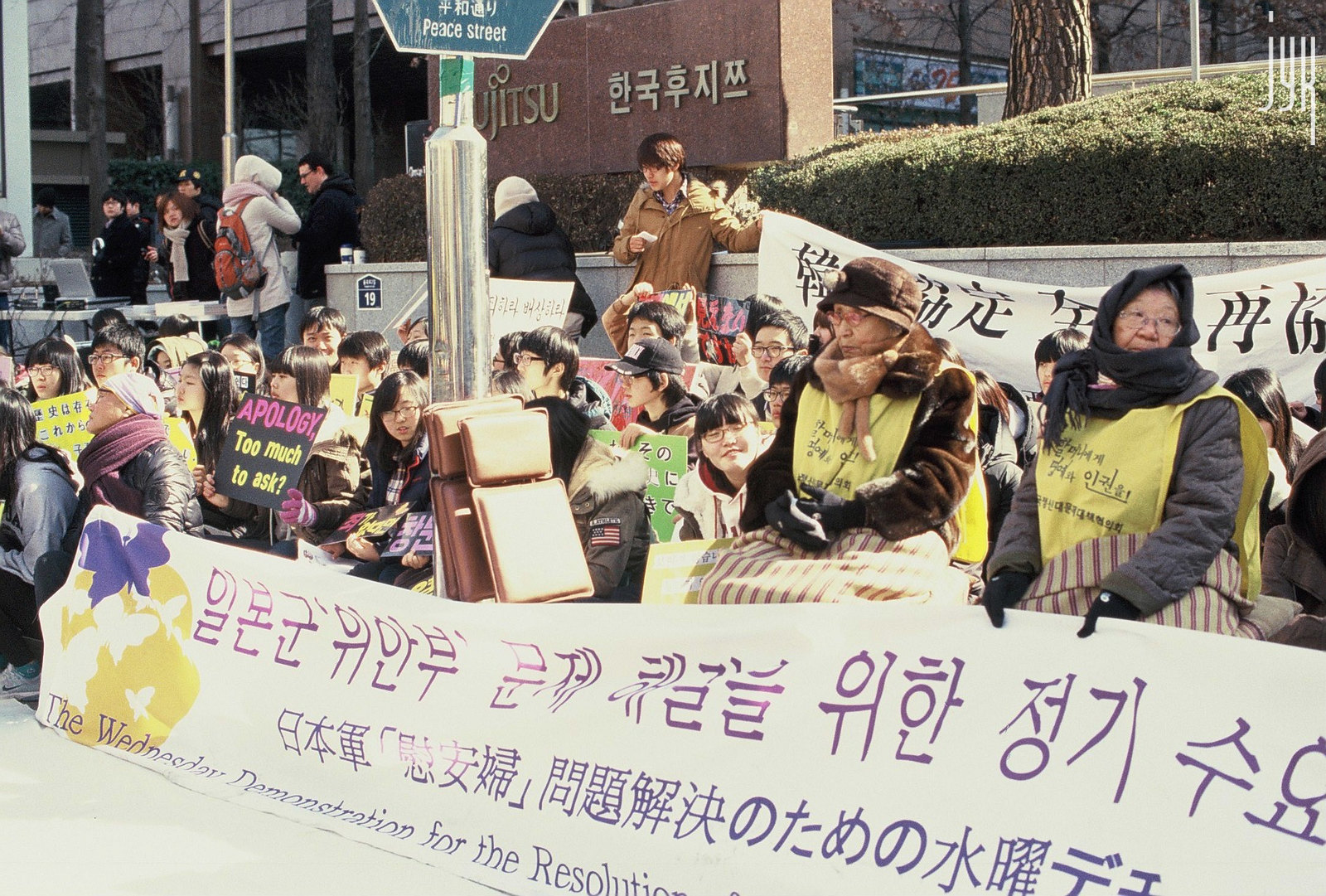
January 15, 2020
The first half of Chang-rae Lee’s A Gesture Life, which celebrated its 20-year anniversary in 2019, ends with the execution of a soldier who has just killed a recently delivered “comfort woman.” His punishment is described as follows:
The officer-in-charge announced that Endo had been charged not with murder, but with treasonous action against the corps. He should be considered as guilty as any saboteur who had stolen or despoiled the camp’s armament or rations.
What is striking about the above passage is not the description of Corporal Endo’s imminent death, but rather the perception of the murdered woman. She is not only not alive, but not a life—she is merely property, not a human at all. Writing about slavery in the U.S. context, Saidiya Hartman has pointed out how the dual invocation of person and property makes issues of consent, will, and agency complicated and ungainly. If a subject is deemed will-less, they are presumed always willing.
January 8 marked the 28-year anniversary of the Wednesday Demonstrations—weekly protests outside the Embassy of Japan in Seoul to demand that the Japanese government apologize for and compensate women who were forced into sexual slavery by the Japanese Imperial Army during World War II—women who are known euphemistically as “comfort women.” The Japanese government has refused to acknowledge and formally apologize for the actions of the military during the war, which has resulted in continued political strain between Japan and other Asian Pacific countries such as South Korea and China.
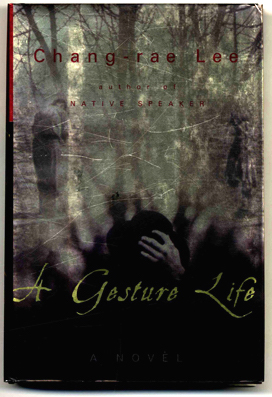
Chang-rae Lee’s 1999 novel A Gesture Life broached the controversial issue, enshrouding the abuse of a Korean military “comfort woman,” named K, by Japanese soldiers in a palimpsestic narrative of nostalgic flashbacks. The novel introduces us to our narrator, Doc Hata, a Japanese man (Korean-born, and adopted by Japanese parents) who in the present-day is a retiree in an affluent suburban neighborhood in New York State. Hata believes he enjoys “an almost Oriental veneration as an elder” in his town of Bedley Run, but the overly assertive statement that opens the novel—“People know me here”—given in the declarative form, belies more than a little insecurity. Through narrative flashbacks, we come to learn about his time as a medic stationed in South East Asia in World War II. He meets K when a group of Korean girls are brought to his station to serve as military “comfort women,” and he develops a close relationship with her, believing that he is protecting her from the evil intentions of the cruel camp doctor, Captain Ono. Finally, however, his cowardice and solipsism result in K’s tragic death. As the novel unfolds, and Hata’s tightly wrought self-image begins to unravel, we see how he is haunted by the ghosts of his past, continually reckoning with his culpability during the war, and visited by the ghost of K, who comes to him “cool and chaste… almost sisterly, alabastrine.”
Lee’s choice of protagonist and narrative voice begs questioning: after interviewing dozens of women with the initial intention to tell the story from the perspective of a “comfort woman,” Lee chose an immigrant Japanese man, Doc Hata, as his narrator. But is it possible to read the privileging of the perpetrator’s perspective in a novel about “comfort women” as not misogynistic? Can a novel with no female voice at its center be about feminist refusal?
Chang-rae Lee spent one year trying to mold a story out of his interviews with women survivors but ultimately felt, as he shared in a 1999 interview with Dwight Garner, that “what [he] had written didn’t quite come up to the measure of what [he] had experienced, sitting in a room with these people.” Lee concluded, “I began to feel that there was nothing like live witness.” But Lee’s reflection on his first draft is telling: “The original story was horrible. It wasn’t that it was badly written, but it was just a horrible story. It’s about comfort women. And maybe I just couldn’t make it interesting aside from being horrible and tragic. So I threw it away after two years, and started a brand new book.” Lee understood intuitively that a first-person narration of repeated and continuous assault would overwhelm a reader and take away any possibility of nuanced commentary on trauma, violence, and culpability. In fact, the occlusion of the female voice in A Gesture Life forces us to come to terms with the impossible task of representing atrocity, and the unreliability of narration, pushing us both to imagine new ways to resist and to read resistance.
◻︎◻︎◻︎
The existence of military “comfort women” was denied and obscured in the decades following World War II, but this began to change in the 1990s. The Korean Council for the Women Drafted for Military Sexual Slavery by Japan, established in 1990, demanded reparations and formal apologies from the Japanese government on behalf of these women. Kim Hak-sun came forward in August 1991 as the first surviving military “comfort woman” to share her story. On January 8, 1992, the first Wednesday Demonstration was held outside the Japanese embassy in Seoul by women protesting the military “comfort women” issue. On February 6, 1996, the United Nations declared its condemnation of Japan for the sexual enslavement of thousands of women by Japan’s imperial troops during World War II. The Korean Chongsindae movement for redress suggests that feminist political activism has been essential to raising the public consciousness about the problem of military “comfort women.”

In fact, books on the issue have been published in Japan since the 1970s and the political mobilizing around of the issue in South Korea and Japan began in the late 1980s. In January 1989, women’s organizations in Seoul staged a demonstration to protest the Korean government’s plan to send an emissary to the funeral of Emperor Hirohito. And in May 1990, the state visit of Korean President Roh Tae Woo to Japan triggered public debate among feminist activists who, speaking to the suffering of the Korean people during Japanese colonial rule, demanded reparations for “comfort women” in particular.
Yet much of the feminist activism around the subject has been dedicated to “giving voice” to these military “comfort women”: Dai Sil Kim-Gibson’s 1999 documentary film was titled Silence Broken: Korean Comfort Women; Washington Coalition for Comfort Women Issues, Inc. published a book in 2000 titled Comfort Women Speak: Testimony by Sex Slaves of the Japanese Military; Therese Park’s essay “To Give a Voice” explains her motivations for her historical fiction on the subject. Even the critical literature on the issue replicates this trope: “The Deafening Silence of the Korean “Comfort Women”: A Response Based on Lyotard and Irigaray” by Constance Youngwon Lee and Jonathan Crowe is one of many essays on the issue that reference silence in their titles.
All this talk about silence obscures the fact that many former “comfort women” were and have been vocal. Insisting that these women continue to need to be given a voice is to render what they have said unheard, robbing them of their voice a second time. In fact, the unquestioned push to “give voice” works to produce the problem of silence, in other words, to make silence a problem that must be remedied.
It is surely important to enable and empower women’s speech. But “giving women voice” does not necessarily mean they will be heard or believed. To assert speech as the ultimate tool for empowerment is to ignore the fact that women have often been coerced or gaslighted into speaking against their own self interest. It is to gloss over the reality that speaking the truth often comes at a cost to their own safety, to elide the fact that survivors are often dependent on and sympathetic to their abusers. It is to insist on the performance of pain in order to have legitimacy. It is to side step the ethical morass of how trauma, once elaborated, is often culturally consumed or fetishized and even academically reified.
At the outset, A Gesture Life may seem to affirm postcolonial theorist Gayatri Spivak’s claim that “the ‘subaltern’ cannot appear without the thought of the ‘elite’”: Yale-educated Lee flies to South Korea to interview surviving “comfort women” only to produce a novel from the point of view of a Japanese soldier. However, the use of a male first-person narrator and protagonist who does much to occlude the actual physical violence involved in the history of military “comfort women” removes the possibility of fetishizing detailed first-person accounts of sexual violence. In other words, Lee’s narrative choices can be read as recuperative and feminist, too.
◻︎◻︎◻︎
During World War II, up to 200,000 women, the majority of whom were Korean, were forced into sexual slavery and made to serve Japan’s military forces. Indeed, rape as an allegory for an attack on national sovereignty is one that is painfully pervasive in war literature: Nora Okja Keller’s novel Comfort Woman, for example, includes a graphic scene in which Induk, one of the military “comfort women” yells, “I am Korea,” while she is raped. In the context of a different war, The Sympathizer by Viet Than Nguyen includes a similar scene in which a double agent, when asked her name, screams “I am Vietnam” as she is gang raped.
But the troubling rape scenes in A Gesture Life are not ones of overt, spectacular violence or of screaming victims, but rather of quiet domination that could frighteningly pass as moments of tenderness. After spending more time with K, Doc Hata begins to have feelings for her. The sinister camp doctor, Captain Ono, has kept K away from the comfort house for unknown reasons, and has finally requested to see her. K desperately pleads with Hata to kill her so she can die with dignity. He cannot agree, and while she feigns sleep, he begins to caress her:
She was sleeping, or pretending to sleep, or somehow forcing herself to, and she did not move or speak or make anything but the shallowest of breaths, even as I was casting myself upon her. […] Then it was all quite swift and natural, as chaste as it could ever be. And when I was done I felt the enveloping warmth of a fever, its languorous cocoon, though when I gazed at her shoulder and back there was nothing but stillness, her posture unchanged, her skin cool and colorless, and she lay as if she were the sculpture of a recumbent girl and not a real girl at all. (260 my italics)
In each instance of abuse, Hata reduces K to an art object: a sculpture or statue. In her essay, “Muteness Envy,” feminist critic Barbara Johnson traces the “idealization of female muteness already in place in the aesthetic tradition” and the ways in which it allows moments of sexual violence to be aestheticized and glossed over. Johnson’s essay opens with an examination of the myth of Daphne and Apollo. Apollo spies the nymph Daphne in the woods, feels the swell of lust, and gives chase. Desperate, Daphne pleads with Zeus for help and is transformed into a beautiful laurel tree and thus escapes sexual violence. Examining this scene, Johnson describes how “[t]he privileged aesthetic moment is a freeze frame just prior to ravishment.” While this “privileged aesthetic moment,” prior to the rape, is excluded by the unreliable narrator Doc Hata, what we do get, perhaps more insidiously, is a freeze frame ex post facto where her rape is retroactively written over, re-inscribed, and rewritten by him as aesthetic, as if it had not touched her. He convinces himself of her consent, and his innocence. But what kind of consent or refusal is possible under domination?—when the utter powerlessness of her “no” means it can always be taken to be a “yes”?

And this is what the passage at the start of this essay reveals: in the context of unspeakable atrocity, in which persons are viewed as property, the speech act has no currency because the subject is seen as having no will. If silence can always be (mis)interpreted as “yes,” and speech has no meaning, what resistance is available?
◻︎◻︎◻︎
Doc Hata remembers K after a seemingly unremarkable scene in a Halloween store in Ebbington:
… he messed up her work. This happened twice more until finally the girl took the cloth and shook it open and placed it over her own head. The boy was confused. She sat there with her face covered in black, and he yelled at her once and then rose abruptly and left her. The girl remained there, under the veil, unmoving for some time…I felt I understood what she was meaning by her peculiar act, how she could repel his insults and finally him by making herself in some measure disappear. As if to provide the means of her own detachment. It was because of this notion—as well as the simple cloth itself, similar enough to the swath Sunny once found in a lacquered box in my closet—that I remember the girl, Kkutaeh, the one I came to call simply K, and the events in our camp in those last months of the war. (221-2)
The girl’s refusal to meet the aggression of the boy with any overt aggression of her own is a display of Bartlebysian politics of refusal—a silent and sustained expression of “I would prefer not to” that is no less uncompromising in lieu of words.
In “Acts of Stillness: Statues, Performativity, and Passive Resistance,” David Getsy, expanding upon Barbara Johnson’s essay, asks, “If, in Johnson’s formulation, muteness becomes the condition that both sparks and authorizes rape, paternalism, and objectification, then how does muteness operate in relation to surrogates for human beings that stand before us and do not speak?” Getsy is thinking here of sculpture. In A Gesture Life, Hata repeatedly aestheticizes K and refers to her as a sculpture or statue before he violates her, as if having turned her into an art object, he is then licensed to defile it—and having been converted to an inert sculpture, she thus assents to her violation.
In the Halloween store, Hata reads the girl’s concealment of herself as an attempt to repel her affronter by disappearing, but it might also be true that in concealing herself she transforms into an unyielding object, unmoved and hence immovable. In her essay “Skins, Tattoos, and Susceptibility,” Anne Cheng writes that “objectification can be a kind of clothing too.” The inverse is also true: clothing (or cloth, at any rate) can cause a kind of objectification. Cloaked in the black silky fabric, the girl does not disappear, but is transformed.
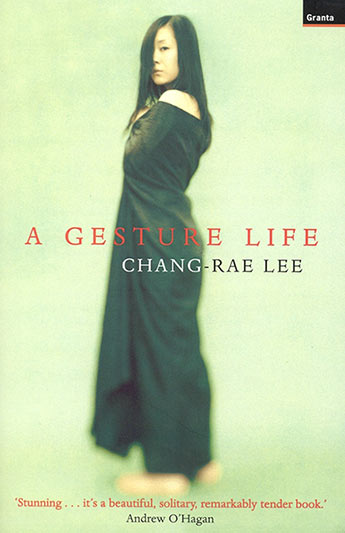
It is not so much the girl’s “retreat,” as Hata reads it, or her silence, that reminds Hata of K, but rather, this sculptural or “object-like” element. The image of the girl in the Halloween store is mirrored in the scene in which Hata first has a significant interaction with K: “Her thick hair had come undone, and it fell in a shiny black cascade, totally covering her face… her dark eyes veiled through the skeins of her hair.” By cloaking herself with hair or the black silk flag, K transforms herself into an inaccessible object, and in this way, is able to retain some form of dignity and integrity. In some ways, Hata’s unreliable narration in the novel does the same for K’s interiority: since we are anchored to a handicapping narrator, we cannot know—just as Hata does not know—the complexity of her suffering. And so the fact of violence and not its traumatic details here should suffice to stir outrage. It comes as no surprise then, that, Doc Hata’s full name is Kurohata, which means “black flag” in Japanese.
With Hata’s jolting flashbacks to an earlier moment of violence, his stylized and pensive prose feels grating and his self-pity and solicitation of pity, insidious. His layered flashbacks have the texture of a labored performance of remorse—simpering attempts to derive pity through a deflated portrayal of self-guilt. If Lee’s novel follows the logic of misogyny, in learning to question and resist it, we learn to resist the logic of misogyny. The ethical import of the novel lies in getting the reader to learn how to recognize rape even when it is romanticized and denied by a sympathetic first-person male narrator. In attempting to convince his audience of his innocence, Hata’s self-pitying tone reveals his attempts to come across as the victim. In her essay “Muteness Envy,” Barbara Johnson writes, “Far from being the opposite of authority, victimhood would seem to be the most effective model for authority, particularly literary and cultural authority. It is not that the victim always gets to speak—far from it—but that the most highly valued speaker gets to claim victimhood” and “if feminism is so hotly resisted… it is because… it interferes with the official structures of self-pity that keep patriarchal power in place.” Instead of reading K as a mute victim, we must recognize Hata’s zealous professions as his desire to claim victimhood, and imagine how K might speak otherwise—what it says when her mute stillness, statue-like, appears strong and stoic in the face of being narrated by someone else and how she might maintain dignity in a situation that allows none.
◻︎◻︎◻︎
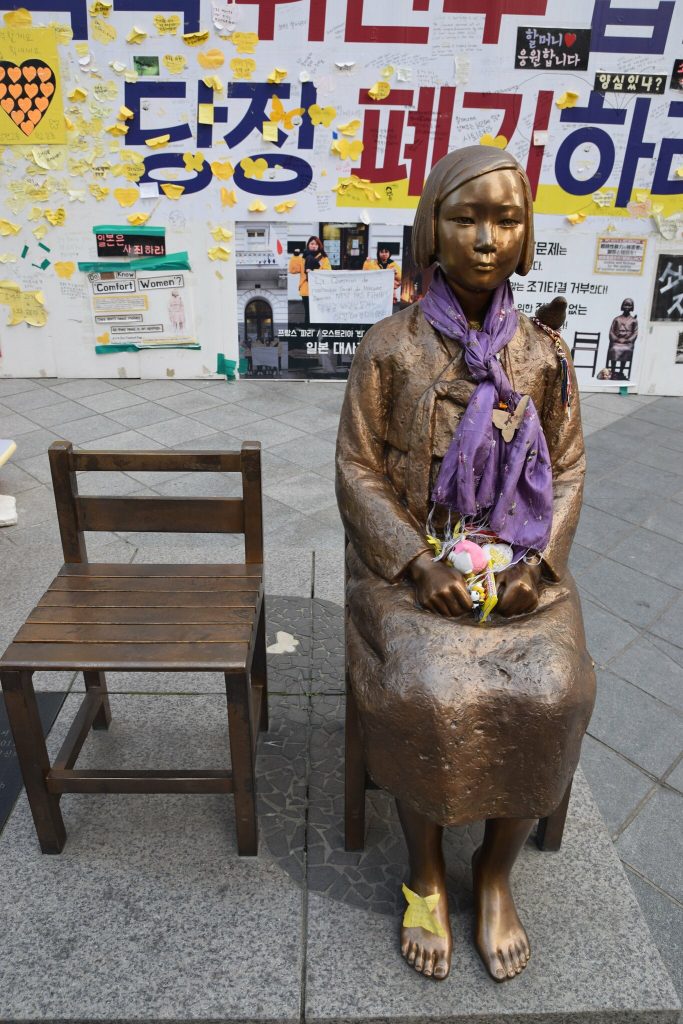
The Wednesday Demonstrations, which began in 1992, hold the Guinness World Record for the longest running protest on a single issue and have played a big role in raising awareness around violence enacted on “comfort women” during the war. But a protest that goes on without end ironically shores up the ineffectiveness of its own form. What happens when noisy protest ceases to effect change? The Wednesday Demonstrations found a new wave of energy when the first comfort woman statue was erected outside the Japan embassy in Seoul on December 14, 2011, commemorating the 1000th demonstration.
Each time a new comfort woman statue is erected, there is a resurgence of interest in the issue and a greater push for accountability and reparations. In December 2015, Japan’s agreement to pay reparations was contingent upon the removal of the comfort woman statue in Seoul. In January 2016, the Japanese ambassador to Korea was recalled in light of the erection of yet another comfort woman memorial in Busan near the Japanese General Consulate. As recently as November 2017, yet another comfort woman statue memorial erected in San Francisco caused the mayor of its sister city, Osaka, to cut ties with the city. The political resonances of the comfort woman statues across the world, and in Korea in particular, offer a way to reimagine and reclaim the passivity so often used to indict women for their own abuse. In becoming a symbol for political engagement and a way to incite community and political dialogue, these silent sculptures challenge speech as the only manifestation of power and agency, and subvert the idea that silence must necessarily be associated with weakness and passivity.
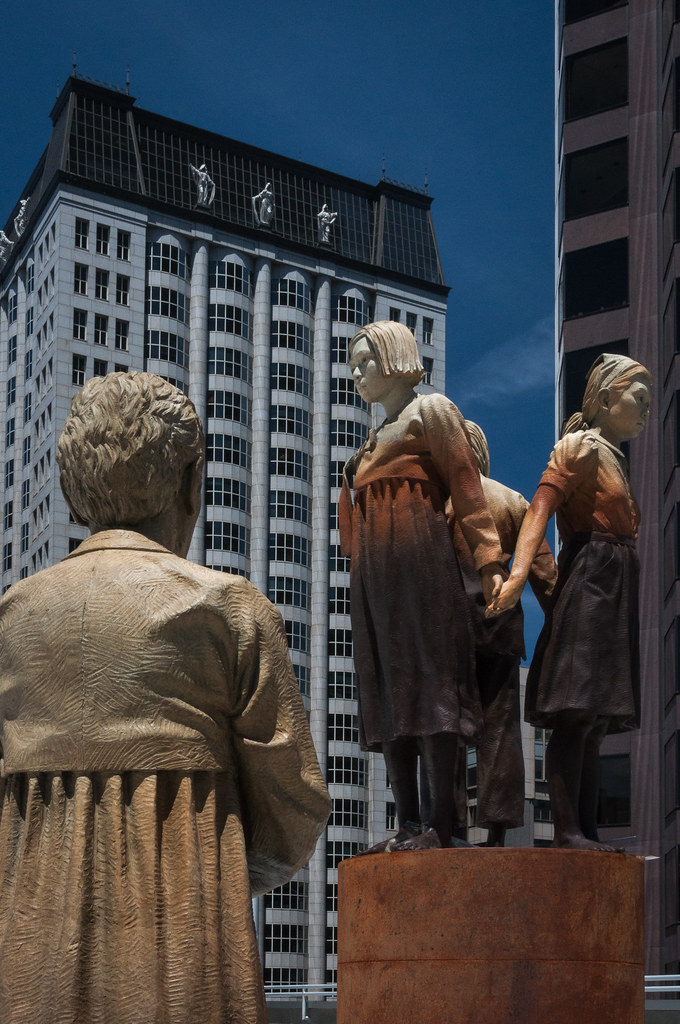
The first sculpture that was erected in 2011, titled Statue of Peace, is of a young girl, hair cut short, with her fists balled up in quiet, but stoic defiance, her feet bare and barely grazing the ground. Often, the sculpture includes an empty chair placed beside the girl, inviting not only participation, but also assembly. Seated, and side by side, one engages with and becomes part of the sculpture, and the sculpture, engaged, becomes a bit more alive. The sculpture is often treated by protestors as “one of their own,” and is routinely clothed and decorated throughout the seasons. In the winter months, it is often wrapped in scarves and hats. No wonder the sculptures feel so threatening despite their quietness: they incite participation, and in other words, proliferation; they promote a politics of solidarity and adjacency. The sculpture seems to beget more of itself—with iterations in Glendale, California, Southfield, Michigan, Seoul, and a second sculpture in Seoul which has literally doubled: the sculpture consists of a bronze Korean girl in traditional Korean dress, and next to her sits a bronze Chinese girl in pigtails in traditional Chinese dress, made by a Chinese sculptor. Leo Shi-yong who made the Chinese statue said, “Two years ago when I first saw the monument made by Kim Woon-sung, I was very moved. But at the same time I felt very lonely. Since Korea and China both suffered at the hands of the Japanese, I thought that a Chinese girl statue might keep the other statue company.” An empty chair next to the two figures serves as an ever-open invitation to join an ever-growing resistance. These contentious sculptures gather about them a vivacity of political energy. The latest memorial in San Francisco has one more girl than the last, comprising three girls to represent three countries: South Korea, China, and Philippines.
The political energy generated by the comfort women statues ruptures the pervasive political stasis around this subject. In this way, sculpture, the body, speech, and non-speech are not separate concepts, but are in fact deeply interdependent and inform each other as forms of resistance and refusal. Judith Butler invites us to consider if it is “right that verbalization remains the norm for thinking about expressive political action.” Indeed, rethinking the privileging of the speech act can allow us to imagine differently what is done by certain kinds of bodily enactments: the way bodies can “do” or “say” or protest even if they are sculpturally silent.
Statuesque, and rendered into a statue, the “comfort woman” K in A Gesture Life is seen to invite her own violation and demise. But the comfort women statues, delicate but resolute, of bronze rather than of alabaster, command a different gaze that opens the space for different action. Should the “comfort woman,” K, be reduced only to her suffering and her role as a victim because she is represented in the dim light of injustice and wartime cruelty? There may yet exist within her a garden and a twilight— forbidden to Hata, and even to us. To reimagine the capacious potential of silence is to allow new possibilities of preserving dignity—to make space for acknowledging the different possible ways that women survive in impossible situations.



